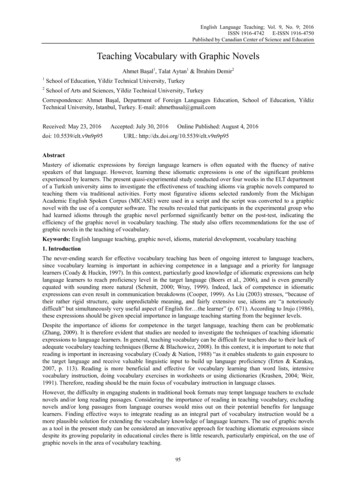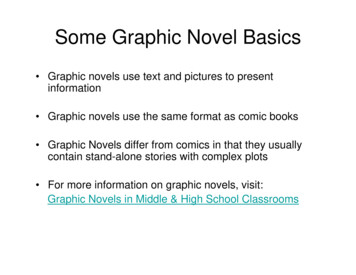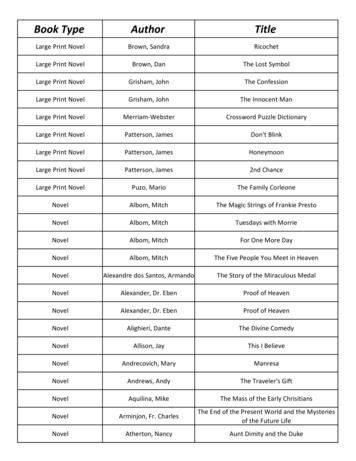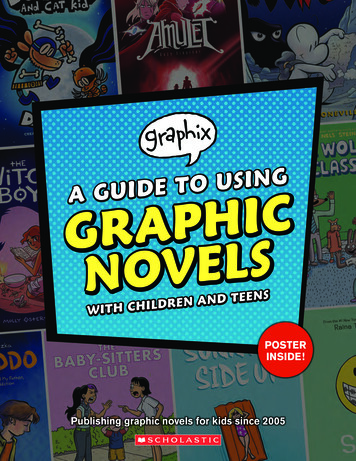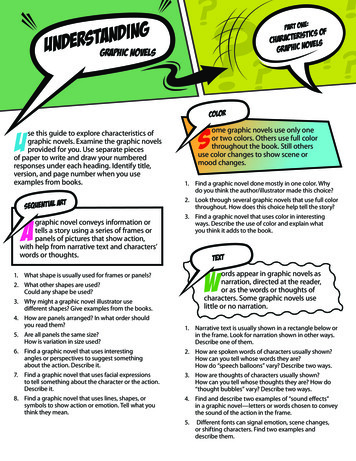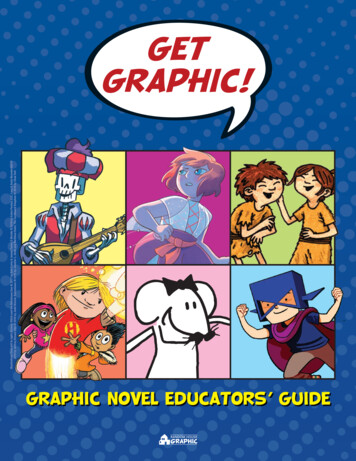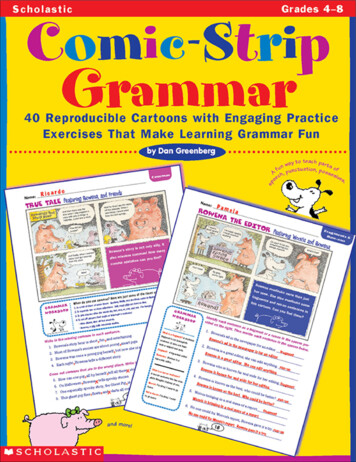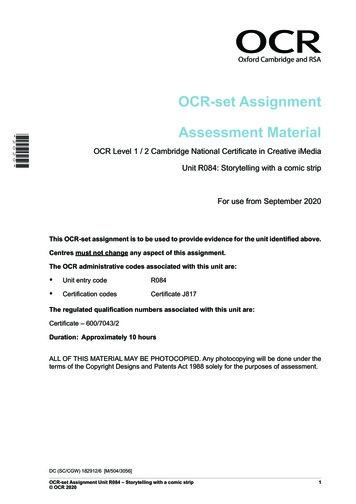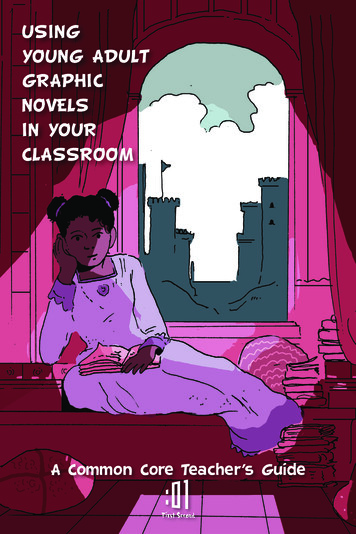![Graphic Novel N. [[see Comic]] 1 : A Book-length Work In Comics Form; A .](/img/31/9780593125243-6573.jpg)
Transcription
graphic novel n. [[see comic]] 1 : a book-length work in comics form;can be fiction or nonfiction; can be any genre; must be long enough to havea spine 2 : one of the coolest ways to read 3 : what you’ll be seeing comingfrom Random House Graphic starting in 2020
Dear Readers,I read a graphic novel for the first time as a teenager.And I loved it.When I was young, I read (and my parents read with me) all kinds of picture books. But as I got older, art starteddisappearing from the pages of the stories that I read. Pictures, it seemed, were only meant for books for very smallchildren (or possibly for scientific diagrams about how cells or engines work). So I read books that were composedsolely of words instead. And I had grand adventures, traveled to far-off (and sometimes imaginary) places, learnedthings about the world, and made new (also sometimes imaginary) friends.At Random House Graphic, our mission is to bring the kinds of stories that I read when I was young to the graphicnovel form. Every kid and teen should have stories with both words and pictures to read throughout their childhood—graphic novels that will find a permanent place in their hearts and minds.We are committed to championing the creativity of our authors, because we believe in the power of graphicstorytelling—and the central place of visual literature in our world and our culture today. Our dedicated team of comiclovers guarantees that our graphic novels will combine wonderful writing, amazing art and high production-quality tomake truly unforgettable stories, across all interests and genres.Our goal? To put a graphic novel on every bookshelf. We think that there should be a comic for everyone, and we wantto make that happen.I’m so excited for you to learn about our imprint, explore our wonderful upcoming books and authors, and findresources to kickstart your own love of graphic novels!Gina GaglianoPublishing Director
What is a GRAPHIC NOVEL?graphic novel n. [[see comic]] 1 : a book-length work in comics form;can be fiction or nonfiction; can be any genre; must be long enough to havea spine 2 : one of the coolest ways to read 3 : what you’ll be seeing comingfrom Random House Graphic starting in 2020Art: Karensaccomic n. 1 : a storytelling format marked byelements of panels, word balloons, text boxes;mostly sequential 2 : a medium or format, nota genre 3 : examples include newspaper comicstrips, political cartoons, gag comics, pamphletcomics [[see superheroes]], mini-comics [[seezines]], graphic novels [[see the format thatkids and teens are falling in love withall across america today because they’reamazing]]Panel: A single drawing (oftencontained within a panel border, oftenrectangular) that consists of onemoment of a comics story.Gutter: The space between comicspanels; the gutter indicates a transitionbetween two moments of the story.Word balloon/speech balloon:Comic characters’ dialogue is shown in aword balloon; often oval, with a tail thatpoints at the speaking character’s mouth.Thought bubble: Comic characters’thoughts are shown in a thought bubble;often cloud-shaped, with small cloudpuffs that form a trail between the bubbleand the character’s mouth.Text box: Narration, especiallynarration not done by a character presentin the panel, and captions in a comic areoften depicted in a box.Sound effect: Non-speech sounds(ex: Crash!) in comics are frequentlyincorporated into the artwork ratherthan being depicted in balloons or boxes.Emanata: Symbolic icons used incomics to indicate specific emotions,moods, or movement. Examplesinclude speed lines (indicating motion),sweat drops (indicating fear, stress,or surprise), stars (indicating injury),and lots more.
Graphic Novels : AN AMERICAN HISTORY198520201895—The first comic strip was published in newspapers.2005—YALSA founds the Great Graphic Novels forTeens list.1933—The first pamphlet comic was published.2007—A graphic novel wins the Michael L. PrintzAward for the first time—Gene Luen Yang’sAmerican Born Chinese.1938–39—Superman and Batman first come intoexistence.1954—The Comics Code Authority is established,restricting publishers’ and authors’ creative freedom.2013—Alison Bechdel’s Fun Home becomes a musical.1978—Will Eisner coins the term “graphic novel.”2016—A graphic novel wins the National Book Awardfor the first time—Congressman John Lewis, AndrewAydin, and Nate Powell’s March.1992—Art Spiegelman’s Maus wins a Pulitzer Prize.2020—Random House Graphic debuts its first list.1965—Manga is first published in the United States.2005—General trade book publishers begin to establishdedicated graphic novel imprints.Graphicnovelstoday{ Are for kids and teens of every ageAre award-winners and bestsellersAre published in every genreAre featured in libraries all over the countryAre sold in bookstores and comics stores allover the countryAre taught in schools from elementary to collegeAre adapted into award-winning moviesAre one of kids’ favorite ways to read
How to Read a Graphic Novel1.2.Start at the beginning. Open the book. Get excited. This will be fun.3.Take your time. Graphic novels have fewer words on a page thanprose novels – but resist the temptation to rush.4.Words AND art are important in a graphic novel! Both the art andthe dialogue have a part to play in the story.5.Every element is intentional. Check out the fonts, backgrounds, character expressions, and body language. It all contributes to the story.6.Graphic novels are created by a wide variety of authors, in a widevariety of styles, genres, and on a range of subjects. No matter whatkind of books are your favorite, you can find graphic novels to love.7.How do you pick? To find graphic novels that appeal to you, check outawards lists and bestseller lists, and ask friends whose book taste youshare.8.Start simple. Practice comics reading skills with kids and YA graphicnovels first. Move on to manga (right to left) and experimentalliterary comics (no panels! stream-of-consciousness storytelling!and more!) once you feel confident.Read left to right, and top to bottom. Start with the first panelin the top left corner and read across from there.9. Challenge yourself! Try reading one graphic novel each month.10. Pick up a new graphic novel and start all over at #1.Art: Karensac, Lucy Knisley
The Debut list!Bug BoysThe Runaway PrincessJoin two bug friends asthey learn about the worldaround them and themeaning of friendship!Princesses don’t run away tohave their own adventures.Right? Not for this princess!By Laura KnetzgerFebruary 2020POB: 13.99 / ISBN 978-1-984-89676-6Ages 7 and UpBy Johan TroïanowskiJanuary 2020PB: 12.99 / ISBN 978-0-593-11840-5HC: 20.99 / ISBN 978-0-593-12416-1Ages 8 and UpAster and theAccidental MagicWitchlightAster is not happy when herfamily moves to the middleof nowhere, away from allher friends—until sheuncovers the magic in hernew town.Love . . . loss . . . witches . . .This thoughtful, emotionalgraphic novel about twowomen traveling andgrowing together willentrance you with itsmoving story andorganic artwork.By Thom Pico and KarensacMarch 2020PB: 12.99 / ISBN 978-0-593-11884-9HC: 20.99 / ISBN 978-0-593-12417-8Ages 8 and UpBy Jessi ZabarskyApril 2020PB: 16.99 / ISBN 978-0-593-11999-0HC: 24.99 / ISBN 978-0-593-12418-5Ages 12 and UpArt: Karensac, Jessi Zabarsky
Coming inKerry and the Knight of the ForestCrabapple Trouble by Kaeti VandornComing to live with your great-aunts is more complicatedwhen they turn out to be witches – and when you then discover that you have some magical powers of your own!For Lori, growing up and getting interested in boys andclothes and television shows seems completely unappealing.Will meeting a ghost change her mind about what it meansto be a kid?Stepping Stones by Lucy KnisleyArt: Laura Knetzger, Lucy KnisleyJen did not want to leave the city. She did not want to moveto a farm with her mom and her mom’s new boyfriend,Walter. She did not want to leave her friends and her dad.Most of all, Jen did not want to get new “sisters,” Andy andReese.When all her friends plan to participate in their town fair,Calla signs up as well—and immediately begins to regret it.How can she learn to cope with her fears about measuringup?Donut Feed the Squirrels by Mika SongWhen a donut truck moves to the park where squirrelsNorma and Belly live, their world opens up to delicious newhorizons!The Magic Fish by Trung Le NguyenSéance Tea Party by Reimena YeeYoung adultMiddle- GradeWitches of Brookyn by Sophie EscabasseYoung chapter bookby Andi WatsonKerry needs to get home—he’s got medicine his parentsneed. But between him and his parents is a dark forest, andits inhabitants seem determined to lead him astray. Who canhe trust?2020When Tam realizes that he’s gay, he wants to tell his parents.But as Vietnamese American immigrants still learningEnglish, will they even have the words to have thisconversation?Suncatcher by Jose PimientaBeatriz just wants to play music. But as her gradesplummet and her band starts missing her, she has tofigure out if music is her life, or just one part of her lifeWITH GRAPHIC NOVELS IN 2021 FROMTARA O’CONNOR – PAULINA GANUCHEAUDAVE SCHEIDT AND MIRANDA HARMONDan Nott – ERIKA MOEN AND MATT NOLANLEE DURFEY-LAVOIE AND VERONICA AGARWALVICTORIA GRACE ELLIOT – AND MORE!
More GraphicNovels fromRandom HouseChildren’s Books!Lucy & AndyNeanderthalby Jeffrey BrownRickety Stitch andthe Gelatinous Gooby Ben Costa andJames Parks5 worldsby Mark Siegel, Alexis Siegel,Xanthe Bouma, MattRockefeller, and Boya SunLunch LadyBabymouseHiloby Jarrett J. Krosoczkaby Jennifer L. Holmand Matthew Holmby Judd WinickNoisemakers:25 Women WhoRaised TheirVoices & Changedthe Worlda nonfictionanthology fromKazoo MagazineThe CardboardKingdomby Chad SellWhite Birdby R. J. Palaciovisitrhcbooks.com
MORE KIDS’ AND YA GRAPHICNOVELS ARE BEING PUBLISHED—AND MORE KIDS AND TEENAGERSARE READING THEMArt: Jessi ZabarskyKIDS’ AND YA GRAPHIC NOVELSTODAY ARE IN A TIME OFUNPRECEDENTED GROWTH.
Art: Laura Knetzger“GRAPHIC NOVELS ARE TEACHING TOOLSFOR THE TWENTY-FIRST CENTURY”- WE ARE TEACHERSKids who love graphic novels love to read.The bottom line is that graphic novels are fun forkids to read. Whether or not they are drawn tobooks, the combination of words and picturesspeaks to kids who love art, who are visuallearners, who like cartoons and video games, andwho like engaging with pop culture. There’s agreat graphic novel for every kid—from the mostvoracious reader to the most reluctant.Graphic novels turn reluctant readers into excitedreaders, and also provide an immersive literarylandscape for advanced readers. For many kidsgraphic novels are a first step in building a lifelonglove of reading.Visual literacy—reading words and imagestogether—is increasingly needed to navigateeveryday life. Reading graphic novels is anamazing place to start leveling up visual literacyskills. Because graphic novels are static, readerscan navigate at their own pace, taking time toreread and think about elements like symbolism,metaphor and implied meanings. Beingthoughtful about the words and images around usis a skill that’s necessary in our very visual world.“The past decade has seenthe dawn of a new goldenage for comics and graphicnovels for kids.”—Publishers Weekly“[Graphic novels] havemoved from the fringesof English or readingclassrooms, where theyonce were reserved forstruggling or reluctantreaders, to the forefront ofinstructional materials.”—NEA Today“These books, which looklike comics on steroids,seem to have near miraculous properties. Theyattract reluctant readersand bookworms. They lureteen boys, while retainingthe qualities beloved byteen girls. They work forESL students, teach visualliteracy and sequencing,and, above all else, theyare wildly popular with anadolescent audience.”—The ALAN Review“Sequential art (the form ofexpression that fills graphicnovels) is a form withsomething to teach us. Thegraphic novel is no longerjust a format suitable to learnabout. It is also starting tobe used as a tool to educate.Beyond simply learning aboutthe production and history ofthe format, the content andthe way it is conveyed arebecoming part of curricularinfrastructure.”—American Libraries“From verbal and visualliteracy to critical thinking andmemory, comics are a greattool to give young readers ahead start.”—The Comic Book LegalDefense Fund“We now know thatcomics—the marriage of wordand picture in a dynamic relationship that fires synapsesacross the brain—can be abridge to literacy and a pathto learning.”—The Washington Post
How to convince your(reluctant) friends that graphicnovels are awesome!1.2.3.4.5.There’s a graphic novel for everyone! Recommend sciencegraphic novels to your friends who love string Theory,fantasy graphic novels to friends who enjoy exploringnew worlds, and memoir graphic novels to . . .you get the picture.Open it up! Show off the art—that’ll do a lot of the workfor you.Give graphic novels to your friends’ kids, and your friendswill eventually get on board through osmosis.Take your friends to a graphic novel author event orconvention! Comics creators are serious and thoughtfuland fun.And maybe this pamphlet can help if you would like thebackground material to embark on an extensive persuasivecampaign full of convincing data?
Follow us online!rhkidsgraphic.com @RHKidsGraphicArt: Johan TroïanowskiEmail us if you love graphic novels!We’d love to hear from you.rhgraphic@penguinrandomhouse.com
moment of a comics story. Gutter: The space between comics panels; the gutter indicates a transition between two moments of the story. Word balloon/speech balloon: Comic characters' dialogue is shown in a word balloon; often oval, with a tail that points at the speaking character's mouth. Thought bubble: Comic characters'

